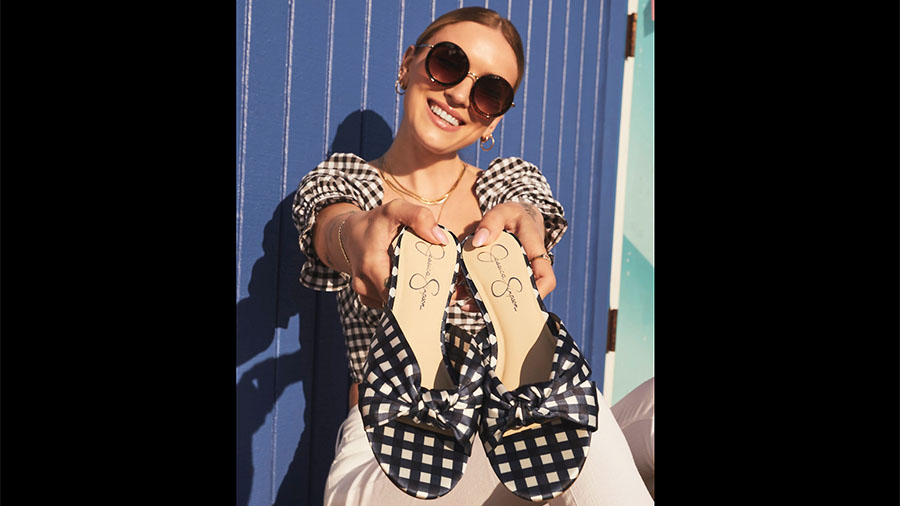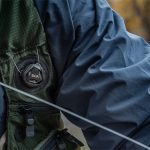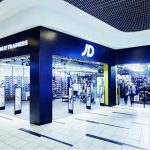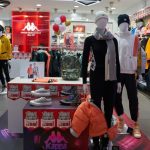Designer Brands reported a continued significant bounce-back in top-line growth for its flagship DSW chain in the fourth quarter as core dressier footwear categories continued to recover and the chain’s push into athleisure and active styles continued to gain market share.
Roger Rawlins, CEO, said the performance reflects steps taken before the pandemic to evolve its strategy that helped DSW, its core banner, expand market share in categories “where the consumer is demanding a broader selection,” such as athletic, kids and men’s. At the same time, DSW has “retained our historic market leadership in dress and fashion as these categories make their post-COVID-19 recovery.”
In the quarter ended January 29, net sales at Designer Brands increased 35.0 percent to $822.6 million. Comparable sales increased by 36.9 percent versus last year’s 20.1 percent decline.
Gross margins improved to 33.4 percent from 13.9 percent last year and 28.6 percent in 2019. Reported net income was $14.4 million, or 19 cents a share, including net benefits of 4 cents per share from adjusted items, primarily related to the change in the valuation allowance on deferred tax assets. The year-ago period showed a net loss of $134.0 million, or $1.85, largely reflecting a valuation allowance change on deferred tax assets.
On an adjusted basis, net earnings in the latest quarter were $11.7 million, or 15 cents, against a loss of $38.6 million, or 53 cents, a year ago.
In the full year, net sales increased 43.0 percent to $3.2 billion. Comparable sales increased 51.6 percent against a 34.2 percent decrease in 2020. Gross margins jumped to 33.4 percent as compared to 13.9 percent last year and 28.6 percent in 2019.
Reported net income was $154.5 million, or $2.00 per share, including net benefits of 30 cents in non-recurring items primarily related to the change in the valuation allowance on deferred tax assets. That compares to a net loss of $488.7 million, or $2.00, a year ago. On an adjusted basis, net income for the year was $131.2 million, or $1.70, against a loss of $281.7 million, or $3.90, a year ago.
U.S. Q4 Comps Jump 36.9 percent
At U.S. Retail, which primarily consists of the DSW chain, sales rose 35.8 percent to $716.3 million. U.S. comp sales were up 36.3 percent versus down 19.7 percent during the same quarter last year.
U.S. store traffic continued its recovery, up 47 percent versus the same quarter last year. Store traffic continues to improve with February store traffic in the U.S. up 46 percent compared to 2021
By category in the U.S., athletic comps were up 35 percent compared to Q419 and 14 percent compared to Q420. Comps grew 26 percent in women’s athletic versus 2019 and 53 percent in men’s athletic, representing market share gains in the category. Athleisure comps were up 21 percent in the quarter versus Q420 and 26 percent from Q419. Athleisure sales penetration was 44 percent for the quarter compared to just 39 percent in Q419.
Seasonal was “again impressive,” said Jared Poff, CFO. Boots comped up 7 percent year over year, driven by regular-priced selling and were up 14 percent versus Q419. Said Poff, “We grew boots sales revenue at DSW 12 percentage points faster than the rest of the market in the quarter ending January compared to the same period in 2019.”
To meet demand for boots, DSW leaned heavily on the company’s owned brands, shifted product orders and pulled forward goods initially slated for early spring.
The dress category continues to recover with women’s dress down 16 percent in the fourth quarter versus 2019, representing a sequential improvement from down 34 percent in the third quarter, down 40 percent in the second quarter, and down 57 percent in the first quarter of 2021, in each case compared to the same period in 2019.
Compared to 2020, women’s dress was up 118 percent in the fourth quarter. Men’s dress also improved slightly to down 18 percent in the fourth quarter compared to down 19 percent in the third quarter and down 30 percent in the second quarter, in each case compared to the same period of 2019.
Kids comps at U.S. retail were up 38 percent compared to Q420 and 44 percent compared to Q419. Kids has grown to 8 percent of the mix in the fourth quarter versus 6 percent in Q419.
Online, sales in U.S. retail grew 39.4 percent versus 2019 and up 10.8 percent year-over-year despite the recovery in in-store sales.
For the full-year at U.S. retail, sales were $2.77 billion, up 53.8 percent. Comps were up 55 percent compared to a decrease of 34.9 percent in 2020. U.S. retail digital demand was up 35.2 percent compared to 2019 and up 12.9 percent compared to 2020.
In its other segments, Canada’s sales grew 46.7 percent in the quarter to $61.8 million. Total comps were up 42.3 percent in the fourth quarter compared to down 27.6 percent in Q4 2020. The segment includes the DSW and The Shoe Company banners in Canada.
Brand Portfolio Segment Sales Climb 42 Percent In Q4
In its Brand Portfolio segment, sales were up 42.1 percent to $74.1 million. The segment develops footwear and accessories through Camuto Group, which owns the licenses rights for Jessica Simpson and Lucky Brand. In partnership with a joint venture with Authentic Brands Group (ABG), the Brand Portfolio segment includes Designer Brands’ stake in Vince Camuto and Louise et Cie.
Wholesale sales were 58.6 percent in the fourth quarter compared to 41.3 percent last year, including sales to our retail segments, which totaled approximately $24.9 million in the fourth quarter compared to $10.1 million in the same period last year.
Jessica Simpson sales in owned channels grew 82 percent in the fourth quarter compared to 2019, and Vince Camuto grew 103 percent in the fourth quarter compared to 2019 with substantial growth coming from Vince Camuto men’s and growth in vc.com.
DSW’s Growth Pillars
Rawlins elaborated on the three “pillars” seen driving Designer Brand’s growth—customer, brand and speed.
On customer, he noted that DSW continues to benefit from recovering demand for dress and seasonal products. According to the NPD Group, DSW sales grew 30 basis points in fashion footwear in the quarter ending in January compared to the same period in 2019, while the rest of the market experienced a revenue decline in the category.
At the same time, DSW’s ramped-up investment in athleisure helped it grow in men’s and kids’ categories within its U.S. retail business to reach record levels in 2021. Sales in athleisure are now up 30 percent compared to pre-pandemic levels with NPD also noting that DSW outpaced the remaining U.S. footwear market in men’s, women’s and kids, including athleisure and fashion footwear compared to the same quarter in 2019 resulting in a market share revenue gain of 40 basis points.
“DSW’s fourth-quarter market share was the highest compared to the last two years,” said Rawlins. “And given we are still underpenetrated to the athleisure category, we believe this growth will continue well into the future. Also in our U.S. retail business in athletic specifically, we posted a comp of 14 percent in the fourth quarter of 2021 compared to 2020.”
In other categories, kids comped up 38 percent in the quarter compared to the same period in 2020, and total men’s sales were up $40 million in the fourth quarter versus the same period in 2020 primarily due to increases in men’s dress, boots and athletic.
DSW, from a profitability standpoint, has benefitted from a reduction in “costly and less productive direct mail and gift-with-purchase to “more productive investments in digital media focusing on brand building and customer acquisition.” In its U.S. retail business, the total cost of marketing and promotions shrunk to 13.2 percent of sales from 25.4 percent of sales in 2020 and 16.1 percent of sales in 2019.
On brand, Designer Brands plans to increase its focus on driving sales of owned brands—Jessica Simpson, Vince Camuto, Lucky Brand, Louise et Cie—through its own direct-to-consumer (DTC) channels, including DSW.
DSW also continues to prioritize its Top 50 brand partners. Said Rawlins, “Our track record of success with brand partners continues to allow us to secure a strong assortment even in constrained inventory environments.
For the full-year, the Top 50 brands, which include some of Designer Brand’s owned brands, represents 77 percent of DSW sales in 2021 compared to 72 percent in 2020. Said Rawlins, “Our focus on these Top 50 brand partners also enabled us to achieve record gross margin rates at both DSW and Canada in the fourth quarter. At DSW, our Top 10 brands within our Rop 50 brands sold over $1 billion in sales for the full-year 2021 contributing 40 percent of our total footwear sales.”
Finally, speed relates to Designer Brands’ capacity to secure inventory in the current supply-constrained environment and its investment in omnichannel capabilities to speed delivery. In 2021, DSW’s customer-facing digital platform eclipsed $1 billion for the first time. DSW stores fulfilled nearly 60 percent of U.S. total digital demand during the year.
The company ended the year with inventories of $586.4 million compared to $473.2 million at the end of 2020.
Rawlins said the company continues to find ways to secure strong levels of inventory despite industrywide supply chain issues.
He said, “Our inventory coming out of 2021 is flat on a square foot basis to 2019, a strong and competitive differentiator compared to our peers. In the fourth quarter of 2021, while we certainly saw the impact of supply chain pressures, we were able to pivot and lean on our own production and our strong relationships with vendor partners. We will continue to pursue a strategy of going narrower and deeper in our inventory investments as the supply chain pressures ease and look forward to the even stronger anticipated benefits this will bring in gross margin, speed to customer and assortment differentiation.”
During the fourth quarter, Designer Brands closed seven stores in the U.S. and four stores in Canada with no new stores opened resulting in a total of 508 U.S. stores and 140 Canadian stores as of the end of 2021.
High-Single-Digit Comp Gains Forecasted In 2022
For 2020, the outlook calls for comparable sales growth in the high-single-digits compared to a growth of 51.6 percent in 2022. Comps at the retail segments are expected to be up 6 percent to 8 percent to full-year 2021, and non-Designer Brands’ wholesale sales are anticipated to grow 20 percent to 30 percent versus 2021.
The strongest year-over-year operating income gains are expected to be in the beginning and ending quarters of 2022, with the middle two-quarters flat to even slightly below last year. Said Poff, “Spring should be stronger growth than fall as Q1 last year was still heavily impacted by COVID for all segments. The recovery didn’t kick in until Q2 for DSW, Q3 for Canada, and later in the fall for Camuto, given product lead times and supply chain pressures in that segment.”
Photo courtesy DSW/Jessica Simpson
















